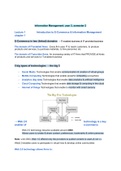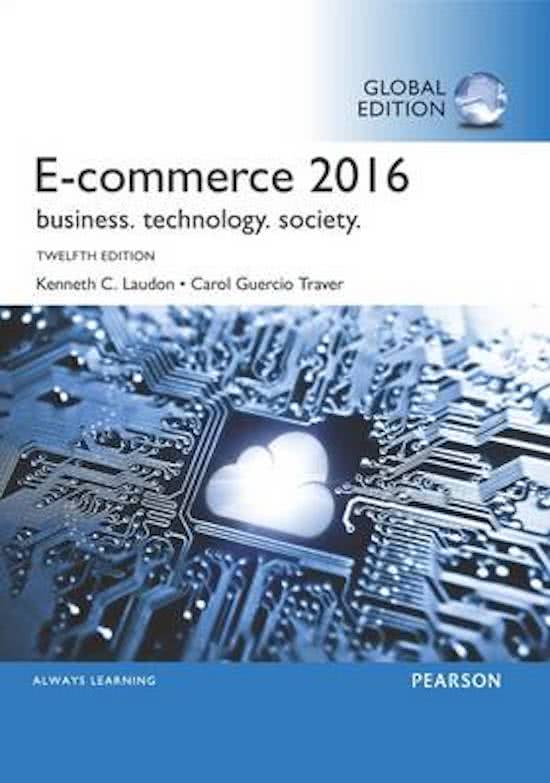Information Management: year 2, semester 2
Lecture 1 Introduction to E-Commerce & Information Management
chapter 1
E-Commerce in two (linked) domains → IT enabled business & IT provided business
The domain of IT-enabled firms: Every firm uses IT to reach customers, to produce
products and services, to purchase materials, to hire personnel, etc
The domain of IT-provider firms: An increasing variety of IT-firms that PROVIDE all kinds
of products and services to IT-enabled business
5 big types of technologies → the big 5
- Social Media Technologies that enable communication & creation of virtual groups
- Mobile Computing Technologies that enable powerful computing everywhere
- Analytics (big data) Technologies that enable data analytics & artificial intelligence
- Cloud Computing Technologies that enable data storage & computing in the cloud
- Internet of things Technologies that enable to monitor with smart sensory
→ Web 2.0 technology is a key
enabler of e-commerce
Web 2.0 technology became available around 2000:
Allows users to create & share content, preferences, bookmarks & online personas
Note: until 2000, Web 1.0 offered only the providers to publish content to users & not v.v
Web2.0 enables users to participate in virtual lives & develop online communities
Web 2.0 technology allows firms to:
, - Build and provide online communities (Twitter, YouTube, Facebook ,Wikipedia, Tinder,
etc)
- Develop business models
“Web 2.0 technology” enables “Social Media Technology”
Information Management →
balancing NEEDS and SERVICES
Business Model:
a set of planned activities (business processes) designed to result in a profit in a
marketplace (value). Information mgt makes use of the following core tools:
Value Modeling: To determine which value is provided by which firm to which client
,Process Modeling: To determine which processes are designed and executed to provide
value (products and services)
Information Modeling: To determine which data are created, used, and exchanged to run
the processes and to provide the value
E-commerce: E- commerce is the application of IT to doing business
E-commerce is (since the 1980s) the result of
Driver 1:competition and business changes
Driver 2:new enabling IT
Interaction between drivers1 & 2=reshaping the business environment
E-business → impact of IT at the firm level
Each firm ‘consists of’ five operational and four supportive processes (Michael Porter VC)
5 operational processes:
inbound logistics, operations, outbound logistics,
marketing & sales, Services
4 supportive processes:
firm infrastructure, HRM, Technological
development, procurement
IT affects;
- all nine business processes PLUS all linkages between these processes
- all contracting between firms
, - Enabling the value chains (firms) to connect into a ‘dynamic (e-commerce) value
system’
Types of E-commerce
Classified by market relationship
Business to Consumer (B2C)
Business to Business (B2B)
Consumer to Consumer (C2C)
Government to Consumer/Business (G2C,G2B)
Other:
Mobile Commerce (M-commerce)
Social e-commerce (Facebook; social networks; communities)
Local e-commerce (Groupon; activities based on geo-locations)
Complicated role of IT as business enabler
Many early visions on e-commerce have not been fulfilled:
- “IT must lead to friction-free markets”
Consumers turned out to be less price sensitive! Considerable price dispersion!
- “IT must lead to perfect competition”
Information asymmetries persist!






